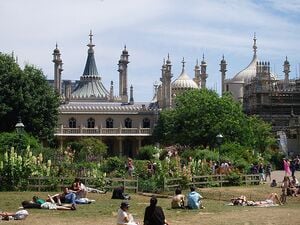The aim of this page is to recognise, celebrate and encourage the self-empowerment of community agency networks (CANs) and community groups across Brighton.

 Five ways community is at the heart of Brighton Festival, positive.news (Apr 24, 2024)
Five ways community is at the heart of Brighton Festival, positive.news (Apr 24, 2024)  Reduce, reuse, and repair for Brighton & Hove Circular Economy Week, brighton-hove.gov.uk (Nov 02, 2022)
Reduce, reuse, and repair for Brighton & Hove Circular Economy Week, brighton-hove.gov.uk (Nov 02, 2022)
This page is the beginnings of a portal for Brighton community action. It focuses mainly on Brighton community action topics. Separate pages cover Brighton community action resources, and Brighton news
Networks and sustainability initiatives[edit | edit source]
- Brighton & Lewes Downs Biosphere project
- Brighton Peace and Environment Centre
- The Green Centre
- Hanover Action for Sustainable Living
- Sussex in Transition on facebook, society of the University of Sussex that acts as a hub for all other student societies focused on sustainability and the environment.
Events[edit | edit source]
Regular events
- Brighton Green Drinks, Brighton Green Drinks on facebook
Events information
- Green Diary, information from the Green Centre
Community involvement[edit | edit source]
- Brighton & Hove City Council Petitions Scheme, (PDF, 11 pages)
Localism[edit | edit source]
Goodmoney CIC, social enterprise based in Brighton & Hove, local gift vouchers.
Climate action[edit | edit source]
Brighton & Hove climate assembly, brighton-hove.gov.uk
Ethical consumerism[edit | edit source]
more video: hiSbe video - Buzzbnk Campaign, April 2013
hisBe, independent supermarket standing up for how it Should be
Sustainable transport activism[edit | edit source]
journeyon, journey planner for Brighton & Hove
Cycling activism[edit | edit source]
Biodiversity[edit | edit source]
The Sussex Wildlife Trust (SWT) is a conservation charity which aims to protect natural life in Sussex. It was founded in 1961 and is one of 46 wildlife trusts across the UK and the Isle of Man and Alderney. As of 2019, it has 33,000 members and manages 2,000 hectares (5,000 acres) of land for nature. It is a registered charity and in the year to 31 March 2019 it had an income of £5.7 million and expenditure of £4 million, resulting in net income of £1.7 million.
The SWT manages twenty-six nature reserves in the county. Nineteen are Sites of Special Scientific Interest, one is a national nature reserve, eleven are local nature reserves, eight are Special Areas of Conservation, three are Special Protection Areas, three are Ramsar sites and seven are Nature Conservation Review sites. Its headquarters at Woods Mill, south of Henfield, is also a nature reserve with a lake, woodland and meadows.
The historic county of Sussex is divided into the administrative counties of East Sussex and West Sussex. The South Downs stretches across the county from west to east. This area is chalk and to the north is the Weald, which is composed of heavy clays and sand. The coast has a succession of holiday towns such as Brighton, Eastbourne, Bognor Regis and Worthing.
Trees, woodland and forest[edit | edit source]
Roots Movement, connecting communities and nature
Coastal community activism[edit | edit source]
- Wild Coast Sussex, sussexwildlifetrust.org.uk/
- Sussex Kelp Restoration Project, sussexwildlifetrust.org.uk
Arts, sport and culture[edit | edit source]
Our Future City, video: Our Future City #BeWell Programme on vimeo
ONCA, "ONCA's mission is to inspire creativity and positive action in the face of environmental change."
Social inclusion[edit | edit source]
Brighton Unemployed Centre Families Project
Emmaus Brighton & Hove, situated in Portslade village on the South coast of England, four miles from the centre of Brighton. It is the largest Emmaus community in the UK, and its "Second-hand Superstore" is the largest second-hand shop in the South of England.[1]
About Brighton[edit | edit source]
Brighton ( BRY-tən) is a seaside resort and one of the two main areas of the city of Brighton and Hove in the county of East Sussex, England. It is located 47 miles (76 km) south of London.Archaeological evidence of settlement in the area dates back to the Bronze Age, Roman and Anglo-Saxon periods. The ancient settlement of "Brighthelmstone" was documented in the Domesday Book (1086). The town's importance grew in the Middle Ages as the Old Town developed, but it languished in the early modern period, affected by foreign attacks, storms, a suffering economy and a declining population. Brighton began to attract more visitors following improved road transport to London and becoming a boarding point for boats travelling to France. The town also developed in popularity as a health resort for sea bathing as a purported cure for illnesses.
As of 2017, Brighton and Hove had a resident population of about 290,885. Brighton has been described as the UK's "hippest city", "the happiest place to live in the UK", and the "unofficial gay capital of the UK". W
See also[edit | edit source]
External links
- Earthship Brighton
- Brighton 'Waste House': The House That Kevin Built, University of Brighton, Faculty of Arts
References



